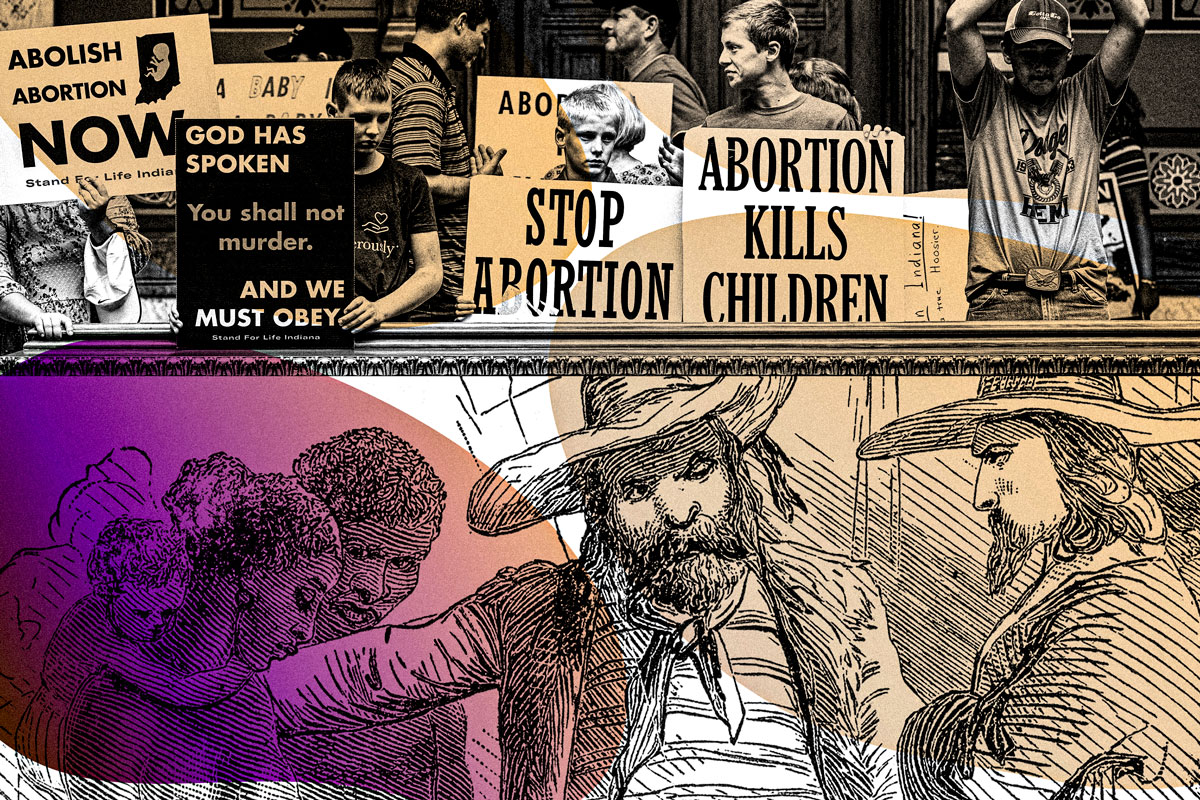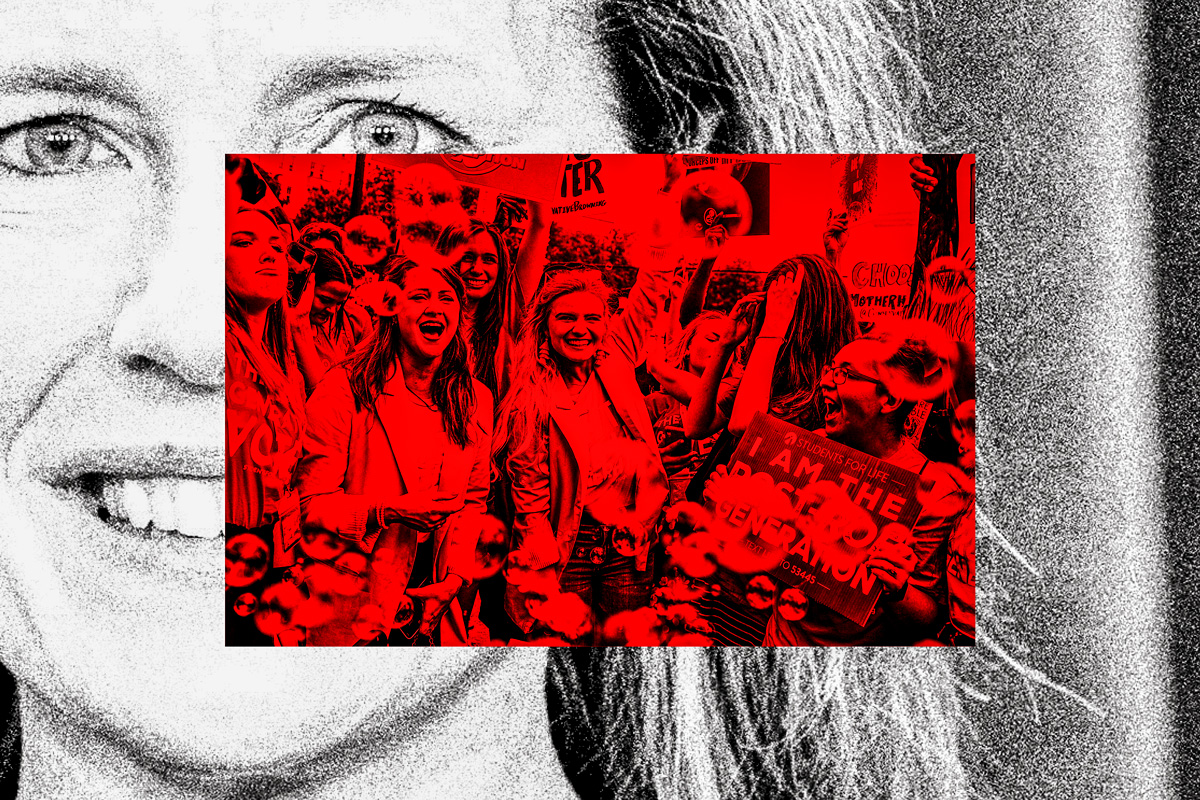If you drove around in the Indianapolis suburb of Greenwood, located in Perry County, you wouldn’t find much to write home about. The same line of box chain stores sell the same items of home décor emblazoned with the motivational slogan “Live, Laugh, Love”; restaurant fare likewise favors the franchised and the bland.
In one respect, though, these exurbanites go in for gothic extremes—when it comes to the politics of reproductive choice. Late last week, the Indiana legislature endorsed SB-1, the nation’s most restrictive ban on abortion access after this summer’s devastating Supreme Court ruling, Dobbs v. Jackson Women’s Health Organization, rolled back the constitutional right to abortion. And one of the right-wing lawmakers behind this regressive bill is Greenwood’s state Representative John Jacob. Jacob is a middle-aged bearded white man who likes to dress up in scrubs smeared with fake blood, representing all the dead fetuses that inhabit his imagination. He’s also the man who stood in the Indiana House during the debate on SB-1 and said, “The body inside of the mom’s body is not her body.”
Extreme as his words and actions are, Jacob spoke for most of Indiana’s Republican supermajority. On September 15, 2022, abortion will be banned in the state, save some flimsy exceptions for incest, rape, the life of the mother, and certain fetal anomalies. And Jacob even voted against those.
His Democratic counterparts from further north in Indianapolis watched in shock and sorrow. At least one, Maureen Bauer, was in tears at the realization that Republicans like Jacob were taking away the right to choose from all Indiana women and child-bearing people. Jacob is but one of the 62 state representatives who voted for SB-1 in the Indiana House; the measure also won the support of 28 state senators.
In reality, the drive to control women’s bodies has always been bound up with the ideology of white supremacy.
Beyond the initial shock of this first-out-of-the-gate measure to roll back reproductive freedom, the broader dynamics behind Indiana’s abortion ban are instructive. To begin with, the demographics of Perry County provide clues to the many ways in which the abortion issue intersects with race and class. The issue of white men taking control of women—and, yes, most of the women who need abortions are Black and brown—has particular resonance within constituencies on the right who fear the end of white dominance in the United States. Perry County is 94 percent white—a striking racial imbalance in a region where several surrounding electoral districts are minority-majority. Another crucial statistic about Perry County is that its residents are overwhelmingly non-college-educated. Only 16 percent of Perry County residents have a college degree. Average income trends below $55,000 a year, with women earning less than even that.
In other words, Perry County is ground zero for many of the racial fears and gender panics that bred the MAGA movement. The racial isolation of the county’s inhabitants, combined with their attachment to white identity in the absence of other avenues of social mobility, means that many of them swallowed the myth of being “replaced” wholesale. That’s why, at the height of the 2020 racial protests over the police murders of George Floyd, Breonna Taylor, and others, students at a Perry Country middle school staged a demonstration to demand that the school’s administration, itself implicated in racism, respond to complaints about the conduct of racist teachers who faced no consequences for their behavior. (Yes, as recently as two years ago, the more prominent brand of school and curricular protest actually concerned racist language and practices within classrooms, as opposed to open discussion of the now-taboo subject of America’s racial past.)
Mainstream press accounts of the anti-abortion movement tend to treat it more-or-less exclusively as a matter of religious conscience for right-wing evangelicals. In reality, though, the drive to control women’s bodies has always been bound up with the ideology of white supremacy. Coerced motherhood was a cornerstone of the antebellum slave regime in the United States—it was, indeed, the means by which the white master class replenished the supply of slave labor. During the early twentieth century’s regime of eugenics, the same brute logic of reproductive control over women’s bodies was held as the key to schemes of racial purity and biological engineering (even though, as abortion foes tirelessly point out, some pioneering advocates for reproductive choice were also white enthusiasts of eugenics).
With measures such as SB-1, this ugly past is once again front and center in American social policy and lawmaking. Like these forerunner regimes of coerced motherhood, today’s abortion bans reinstitute a patriarchal order ensuring that the dominion over women’s body belongs to someone else. Under the dictates of these bans, a woman’s body is suddenly “not her body” nor is autonomy over her physical being a matter of “her choice,” as John Jacob has put it.
Like slavery, abortion involves the forced imposition of labor from a class steeped in the impunity of white identity. A forced pregnancy imposes all sorts of labor on women; the experience of child-bearing involves fatigue, urinary issues, weight gain, body aches, digestive issues and emotional hardship. The condition of pregnancy takes over the entire body and abridges the ability of the mother to do other things. The weight of all this—something unknown to many men, and unacknowledged by the men resurrecting the ideology of forced childbirth—is significant. The forced pregnancies normalized under laws such as SB-1 will go to term simply because this collective surrender of bodily autonomy suits the interests of white men in legislative assemblies.
Under the dictates of these bans, a woman’s body is suddenly “not her body” nor is autonomy over her physical being a matter of “her choice.”
For the inhabitants of Perry County and many other counties in deep red Indiana, the abortion ban is clearly of a piece with the re-invigorated ideology of white nationalism. In “protecting life,” the ban re-asserts the right of a white establishment to determine what women are permitted to do with their bodies. This re-assertion of dominion over a body not one’s own is a far-from-subtle reprisal of the logic behind the system permitting white people to own slaves.
Like other fantasies of “owning the libs” via the blunt instrument of bans on bodily autonomy and intellectual self-determination, this one is self-defeating. Even before the ban passed, Indiana-based businesses and corporations were issuing statement after statement about how it would adversely affect everything from jobs to the availability of women’s healthcare in general—something that Indiana, the third worst state for maternal mortality in the United States, would do well to take seriously. Pharmaceutical giant Eli Lilly, one of the state’s largest employers, whose campus in downtown Indianapolis houses 10,000 workers, said that SB-1’s passage will impair its ability to attract a top-tier and diverse workforce. The company has already added travel for reproductive services to the coverage provisions of its health plan. Cummins, the engineering corporation that has 10,000 employees in Indiana, has already stated that it opposes the ban and that “women have the right to make decisions regarding reproductive health”—a critical freedom that also “ensures that women have the same opportunity as others to participate fully in our workforce and that our workforce is diverse.”
The Indiana that these major employers and liberal-minded workforces call home is just a 10-minute drive on the interstate from Perry County. The people in this Indiana are also mostly white, but still share at least a theoretical openness to diversity that is welcoming to people of color. Planned Parenthood is here, along with an annual well-attended Pride Parade. In class terms, the ban on abortion is also an effort to stick it to this Indiana—the wealthy educated upper-middle-class, many of whom still lean Republican but still abhor the raw culture-war confrontation favored in MAGA settlements like Perry County.
Scared white nationalist Indiana has won for now. It’s managed to focus its demographic and economic insecurities, and its frustration over downward mobility, onto a retrogressive law that highlights just how livid the people left behind really are. In doing so, the SB-1 partisans have set themselves apart from the Indiana looking ahead instead of into the past. The hallowed dogmas of American progress have long held that the forces of forward-thinking inclusion are supposed to win. The fact that they have not is a lesson in how white nationalism, class-driven cultural antagonism, and self-defeating patriarchal social engineering have all coalesced into a fight over abortion and whether women get to have control over their own bodies.
Rafia Zakaria is the author most recently of Against White Feminism (W.W. Norton, 2021). She is also a columnist for The Baffler and Dawn (Pakistan).



